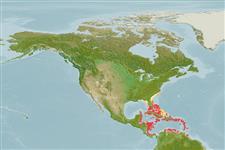>
Eupercaria/misc (Various families in series Eupercaria) >
Scaridae (Parrotfishes) > Sparisomatinae
Etymology: Sparisoma: Latin, sparus = a fish with a golden head + Greek, soma = body (Ref. 45335).
More on author: Valenciennes.
Environment: milieu / climate zone / depth range / distribution range
Ökologie
seewasser riff-verbunden; tiefenbereich 1 - 15 m (Ref. 9710). Tropical; 42°N - 7°N, 88°W - 59°W (Ref. 88982)
Western Atlantic and the Caribbean. Confused with Southwest Atlantic specimens referring to Sparisoma axillare and Eastern Atlantic species referring to S. chaoti (Ref. 88982).
Length at first maturity / Size / Gewicht / Alter
Maturity: Lm ?, range 16 - ? cm
Max length : 47.8 cm TL Männchen/unbestimmt; (Ref. 13628)
Rückenflossenstacheln (insgesamt): 9; Rückenflossenweichstrahlen (insgesamt): 10; Afterflossenstacheln 3; Afterflossenweichstrahlen: 9. Juveniles and adults in drab phase (which are either mature males or females) are light grayish brown, nearly white ventrally; alternate dark and pale bars cross the chin; caudal peduncle and fin yellow; anal and pelvic fins red. Terminal phase males are dull green or blue-green with a large black spot on upper half of pectoral fin base; pectoral fins dark olive, the outer fifth abruptly pale (Ref. 13442).
Inhabits coral reefs and seagrass beds. Juveniles or primary-phase fish can rapidly assume a mottled pattern as it comes to rest on the bottom. Spawning is usually a group activity in similarly colored males and females (Ref. 5521). A protogynous hermaphrodite (Ref. 55367).
Life cycle and mating behavior
Geschlechtsreife | Fortpflanzung | Ablaichen | Eier | Fecundity | Larven
Although protogyny was propossed for this species (Ref. 27876), probably because testicular characteristics showed a secondary characteristic of sex-changed males, observations of overlapping size ranges of males and females, and males maturing at the same ages and sizes as did females, strongly suggest gonochorism (Ref. 103751). A monandric species (Ref. 55367). Length at sex change = 25.0 cm TL (Ref. 55367). Forms leks during breeding (Ref. 55367).
Lieske, E. and R. Myers, 1994. Collins Pocket Guide. Coral reef fishes. Indo-Pacific & Caribbean including the Red Sea. Haper Collins Publishers, 400 p. (Ref. 9710)
IUCN Rote Liste Status (Ref. 130435)
Bedrohung für Menschen
Reports of ciguatera poisoning (Ref. 30303)
Nutzung durch Menschen
Fischereien: weniger kommerziell; Aquarium: Kommerziell
Mehr Information
ReferenzenAquakulturAquakultur ProfilZuchtlinienGenetikElectrophoresesVererbbarkeitKrankheitenVerarbeitungNutrientsMass conversion
PartnerBilderStamps, Coins Misc.LauteCiguateraGeschwindigkeitSchwimmstilKiemenoberflächeOtolithsGehirngrößeSehfähigkeit
Tools
Zusatzinformationen
Download XML
Internet Quellen
Estimates based on models
Preferred temperature (Ref.
123201): 23.9 - 28.2, mean 27.5 °C (based on 467 cells).
Phylogenetic diversity index (Ref.
82804): PD
50 = 0.5000 [Uniqueness, from 0.5 = low to 2.0 = high].
Bayesian length-weight: a=0.00912 (0.00543 - 0.01532), b=3.05 (2.91 - 3.19), in cm total length, based on LWR estimates for this species & Genus-body shape (Ref.
93245).
Trophic level (Ref.
69278): 2.0 ±0.0 se; based on diet studies.
Generation time: 1.9 ( na - na) years. Estimated as median ln(3)/K based on 2
growth studies.
Widerstandsfähigkeit (Ref.
120179): hoch, Verdopplung der Population dauert weniger als 15 Monate. (K=0.5).
Fishing Vulnerability (Ref.
59153): Low to moderate vulnerability (26 of 100).
Nutrients (Ref.
124155): Calcium = 49.2 [29.2, 92.7] mg/100g; Iron = 0.715 [0.384, 1.213] mg/100g; Protein = 18.5 [16.2, 20.8] %; Omega3 = 0.0933 [, ] g/100g; Selenium = 30.9 [17.7, 58.7] μg/100g; VitaminA = 40.1 [12.0, 135.4] μg/100g; Zinc = 1.6 [1.1, 2.5] mg/100g (wet weight);
